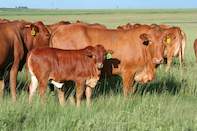
Afrikaner cattle are an indigenous breed with a hump. They seem to have originated from wild cattle, on the Asian steppes, that moved through Africa, from Egypt to the tropics and Sahara until finally arriving in South Africa.
The arduous journey resulted in an extremely hardy, no-nonsense breed, with the animals being well adapted to arid conditions, extreme heat, tropical diseases and internal and external parasites.
The Khoi people already farmed with these animals by the time Jan van Riebeeck reached the Cape in 1651, while Portuguese sailors back in the fifteenth century already reported sightings of the cattle in the south-western regions of the country.
The breed played a crucial role in the Great Trek, from 1834 onwards, with an estimated 200 000 Afrikaner and Afrikaner-type cattle forming part of the Voortrekker cattle herds and an additional 30 000 draught oxen being used to pull 3 000 ox wagons.
The Afrikaner Cattle Breeders’ Society has played an important role in steering the genetic development of these animals, resulting in what is known as the modern Afrikaner breed today: An extremely hardy breed, with the ability to produce exceptional meat with minimal inputs.
According to society, it is one of the only cattle breeds that can truly be produced in extensive veld conditions throughout the year. It also forms a partial foundation of various other breeds, such as the Bonsmara and Belmont Red breeds.
 Afrikaner cattle originated from wild cattle on the Asian steppes. Afrikaner cattle are produced throughout South Africa, as well as in some...
Afrikaner cattle originated from wild cattle on the Asian steppes. Afrikaner cattle are produced throughout South Africa, as well as in some...